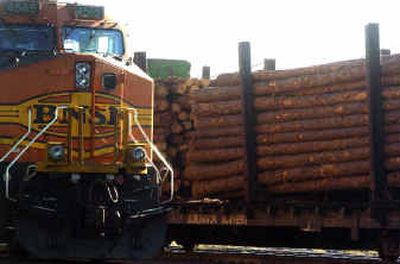Against the grain

Every morning around 7 o’clock, the windows start to rattle at Vaagen Brothers Lumber Co. When Duane Vaagen looks out, he sees a string of railcars rushing by.
Each car is piled high with Canadian lumber. It’s a disconcerting sight for Vaagen, president of a family-owned sawmill in Colville. “They’re just kind of in our face,” he said.
Today, Vaagen is in Washington, D.C., encouraging the U.S. government to continue a 27 percent tariff on Canadian lumber rolling over the border.
He’s one of several mill owners testifying before the U.S.-based International Trade Commission. Through their testimony, Vaagen and other mill owners hope to demonstrate that unchecked Canadian lumber imports have hurt the U.S. industry.
Their testimony is another round in a trade war that has lasted more than a century. The stakes are high for mills on both sides of the border.
Canada produces about one-third of the softwood lumber sold in the United States. The commodity spruce, fir and pine compete directly with lumber from U.S. mills.
Vaagen’s Colville mill lies a scant 50 miles from the U.S.-Canadian border. But the other side is an entirely different world, Vaagen and other U.S. producers believe.
For years, they’ve accused the Canadian government of subsidizing its mills through low-cost log sales.
“There’s never been any mystery to that. They use their mills as a tool to boost rural employment,” said Harry Clark, an attorney for the Coalition for Fair Lumber Imports, which represents U.S. producers. “Our producers don’t have that advantage.”
The Bush administration agreed. In May 2002 it imposed duties of 27 percent on lumber coming from Canada.
Canada appealed the decision to the World Trade Organization. After a WTO ruling in April, the United States agreed to reassess its ruling that Canadian imports threatened the domestic industry.
“We’re in Washington this week to reinforce what should be obvious, that … those unfair imports threaten this industry with injury,” said Rusty Wood, chairman for the Coalition for Fair Lumber Imports.
Clark said he’s confident the tariffs will stand. In an earlier ruling this year, the WTO established that the U.S. government could measure subsidies based on what the timber would have sold for in the United States, he said. The Commerce Department found that the subsidies amounted to $1.6 billion per year.
Tariffs aside, U.S. producers say what they really want is a level playing field with Canada. If Canadian provinces – which own the majority of the timberland in Canada – would agree to sell their timber at market prices, it would be fine to open the borders to Canadian lumber, they said.
“We don’t want to see lumber prices go too high, we just want to see some certainty,” Vaagen said.
Lumber prices are dropping rapidly after reaching 10-year highs this summer. Without protection for U.S. producers during weak markets, Canadians will keep grabbing up market share, while U.S. producers will curtail operations and lay off workers, Vaagen said. That happened in 2001, which he deemed a “brutal year” for the industry.
In the last 25 years, Canada’s share of the U.S. lumber market has grown from less than 20 percent to its current third of the market.
“Why?” is a question that economists ponder, said John Perez-Garcia, an associate professor at the University of Washington’s College of Forest Resources.
“Has all that growth in market share occurred because the Canadians are better at producing wood?” he said “Or, has it occurred because they’re getting help?”
Until the two countries come closer to a uniform system for selling timber, they’ll continue to fight political battles over softwood imports, he predicted.
Canadians are also anxious for a long-term solution, said John Brink, who lives 500 miles north of Vaagen’s Collville mill, in the heart of British Columbia’s spruce country.
Brink, a 63-year-old immigrant from Holland, owns Brink Forest Products. His three mills turn out 125 million board feet of lumber each year, most of it headed for U.S. markets in the Midwest and the East.
“We have been victims of tariffs for nearly the last 20 years,” Brink said. “The most punitive for us, by far, has been the last one.”
The tariffs have driven some of his Canadian colleagues out of business, he said, and forced him to squeeze every efficiency possible out of his mills and workers. They’ve been widely felt in his hometown of Prince George, dubbed the “Spruce Capital of the World,” by its residents.
“By and large, we’ve been kind of hanging in there,” Brink said.